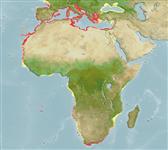分類 / Names
共通名の | 類義語 | Catalog of Fishes(部類, 種) | ITIS | CoL | WoRMS | Cloffa
>
Eupercaria/misc (Various families in series Eupercaria) >
Sparidae (Porgies)
Etymology: Diplodus: Greek, diploos = twice + Greek, odous = teeth (Ref. 45335).
More on author: Linnaeus.
Issue
This subspecies is reported to have no genetic difference between the subspecies Diplodus sargus cadenati. See V.S. Domingues et al. 2007. Journal of Experimental Marine Biology and Ecology 346 (2007):102-113 (F. M. Porteiro, pers.comm. 02/08). Presence in Canary Is. to be reviewed since D. bellottii and D. cadenati are recognized as valid species, not any more as subspecies of D. sargus.
Environment: milieu / climate zone / depth range / distribution range
生態学
海; 汽水性の 底生の; 海洋回遊性 (Ref. 51243); 深さの範囲 0 - 50 m (Ref. 12460), usually 0 - 50 m (Ref. 13780). Subtropical; 48°N - 36°S, 29°W - 42°E
Northeastern Atlantic from Brittany (France) to Gibraltar, and Madeira I.; Mediterranean Sea and southwestern Black Sea.
Length at first maturity / サイズ / 重さ / 年齢
Maturity: Lm ?, range 25 - ? cm
Max length : 45.0 cm TL オス/雌雄の選別がない; (Ref. 3397); common length : 22.0 cm TL オス/雌雄の選別がない; (Ref. 3397); 最大公表体重: 1.9 kg (Ref. 40637); 最大記録サイズ: 10 年 (Ref. 26328)
背面の脊椎 (合計) : 11 - 12; 背鰭 (合計) : 12 - 15; 肛門の骨: 3; 臀鰭: 11 - 14. Body with 5 black and 4 grey vertical bands. Snout is longer than the eye diameter (Ref. 35388).
Inhabits coastal rocky reef areas (Ref. 12460) and Posidonia oceanica beds. Like other sparids, it is very active and frequents the surf zone, primarily at dawn (Ref. 13780). Feeds on shellfish and other benthic invertebrates which it picks from the sediment (Ref. 5377).
Sexes separate or protandrous (Ref. 4781). In some areas, this species occurs as a digynic hermaphrodite, that is, males and females developing from intermediate juveniles (Ref. 52202). However, protandry with possible digyny was later confirmed (Ref. 103751). Reaches sexual maturity at 2 years, with an approximate size of 17 cm. Spawning happens from January to March. Egg size 0.8-0.9 mm; larval length at hatching 2.6 mm. Also Ref. 28504.
Bauchot, M.-L., 1987. Poissons osseux. p. 891-1421. In W. Fischer, M.L. Bauchot and M. Schneider (eds.) Fiches FAO d'identification pour les besoins de la pêche. (rev. 1). Méditerranée et mer Noire. Zone de pêche 37. Vol. II. Commission des Communautés Européennes and FAO, Rome. (Ref. 3397)
Human uses
水産業: 少数商業の; 水産養殖: 商業; ゲームフィッシュ: はい
用具
特記事項
XMLをダウンロードして下さい
インターネットの情報源
Estimates based on models
Preferred temperature (Ref.
123201): 15 - 24.1, mean 18.8 °C (based on 400 cells).
Phylogenetic diversity index (Ref.
82804): PD
50 = 0.5000 [Uniqueness, from 0.5 = low to 2.0 = high].
Bayesian length-weight: a=0.01175 (0.01050 - 0.01315), b=3.04 (3.01 - 3.07), in cm total length, based on LWR estimates for this species (Ref.
93245).
栄養段階 (Ref.
69278): 3.4 ±0.1 se; based on diet studies.
回復力 (Ref.
120179): 手段, 1.4年~4.4年の倍増期間の最小個体群 (K=0.11-0.25; tmax=10; tm=2).
Prior r = 0.54, 95% CL = 0.35 - 0.80, Based on 5 data-limited stock assessments.
Fishing Vulnerability (Ref.
59153): High vulnerability (57 of 100).
Climate Vulnerability (Ref.
125649): Low to moderate vulnerability (26 of 100).
Nutrients (Ref.
124155): Calcium = 74.5 [38.6, 152.0] mg/100g; Iron = 0.993 [0.559, 1.844] mg/100g; Protein = 19.7 [18.8, 20.6] %; Omega3 = 0.35 [0.20, 0.60] g/100g; Selenium = 20.9 [9.8, 39.7] μg/100g; VitaminA = 15 [5, 42] μg/100g; Zinc = 1.01 [0.69, 1.43] mg/100g (wet weight); based on
nutrient studies.
